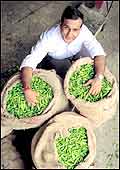 |
PRADEEP G. NAIR
Koeleman India
Koeleman's Nair sees
a long-term advantage for India in an export crop like gherkin
that involves a 30-day sow-to-harvest operation |
Ankush
Aggarwal is looking to charter an aircraft for a twice-a-week flight
to London from Delhi. On board will be a cargo of baby corn, broccoli,
snow peas, onion, chillies, okra, and yam from Punjab. Final destination:
the fast-moving shelves of UK retailers such as Tesco and Sainsbury's.
The quest may seem ambitious, but the 30-year-old chemical engineer
is dead serious. Aggarwal has already shipped several consignments
to Europe and is busy watching his Rs 20-crore dream, Punjab Agri
Food Parks Ltd., come to life at Fateh Singh Garh, a nondescript
village located 60 km away from Chandigarh. Also living this dream
are farmers from remote villages in the Patiala district of the
state: Kuljit Singh of Rai Manjira and Gurjit Singh of Chambala
are two such. A large landholder with 52 acres, Gurjit has already
committed nearly 10 acres to Aggarwal's food parks; he will grow
baby corn, chillies, cabbages and tomatoes on this land. And Kuljit
has dedicated 12 acres to the project. An year from now, Aggarwal
hopes to export 40 tonnes of vegetables a day.
 |
VIJAY SINGH
Vijay Floriculture & Seeds
Uttaranchal-based
Singh's visits to Delhi's flower markets are likely to get less
frequent as he shifts to growing oriental lilliums and carnations
for exports |
A success story is slowly emerging in some of
the country's 48 agri export zones (AEZs), a Rs 1,325-crore government
initiative aimed at boosting exports. In AEZs across Uttaranchal,
Punjab, Maharashtra, Karnataka, Andhra Pradesh, and Tamil Nadu,
around 4,000-and-rising farmer-exporters have already started shipping
their produce to international markets; others are drafting plans
to export their next harvest; and some 32,000 farmers are currently
being trained by the Agricultural and Processed Food Products Export
Development Authority (APEDA). "There's now talk of taking
us abroad to understand the nature of crop pattern," gushes
Kuljit Singh. "That will be a valuable input."
The AEZs, founded in late 2001, have already
exported agricultural produce-this includes gherkins, mangoes, vegetables
and litchis-worth Rs 450 crore. That isn't such a big number. What
is, is APEDA's projection that the AEZs will export over Rs 10,300
crore of agricultural produce by 2007. "You cannot judge the
success of AEZs from the current export performance of these regions,"
says Ranjan Kedia, Managing Director, Radha Krishna Impex Private
Ltd. "It's all about starting an export movement." Kedia
moved to litchis from soyabean five years ago and boasts an export
turnover of Rs 3 crore. He believes he has merely scratched the
surface of a $100-billion (Rs 4,60,000 crore) international opportunity
and has drawn up plans to diversify into other lucrative crops like
exotic vegetables and mangoes.
 |
DR. N. BARATHI
Growmore Bio-Tech
Hosur-based Growmore
Bio-Tech has carved out a niche for itself by exporting tissue-cultured
plants to Japan and Australia |
That belief is echoed by Himmat Singh, Chairman,
Punjab Agri Export Corporation Ltd., the nodal agency for AEZs in
Punjab. "We have just made a start," he says. "Let
the cold chain and quality facilities come in and you will see a
major impetus." Adds K.S. Money, Chairman, APEDA, ''What we
bring in is export focus and coordination that have been lacking
in states so far.'' And so, the government has focused on creating
an environment conducive to exports and changing the mindsets of
farmers who have traditionally grown rice, wheat, and the occasional
maize, barley, and mustard. The results are beginning to show. "Until
now, there has been limited output available for exports and there
are too many players. However, with the infrastructure facilities
being set up in interior villages as part of the AEZ project, the
output is bound to increase," says Piyush Shah, an aspiring
fruit exporter based in Mumbai. Starting this month, Shah will export
150-180 tonnes of grapes every season to West Asia and Europe. Next
summer, he plans to diversify into mangoes. Fruits are alright,
but it is a vegetable rarely used in Indian cuisine that is the
biggest export success story of them all.
 |
RANJAN KEDIA
Radha Krishna Impex
Kedia's Radha Krishna
Impex moved to litchis from soyabean five years ago and today
boasts an export turnover of Rs 3 crore |
The Coming Of The Gherkin
Satya Priya Mazumdar is a 53-year-old former
Unilever pro who swears by gherkins. In 1992, an Italian friend
of his was trying to source gherkins from a reliable source; he
was looking for an alternative to his primary source, civil-war
ravaged Sri Lanka. The gherkin-a mini-version of a cucumber-is not
used in Indian cuisine; and it was never a part of Indian agricultural
landscape. Mazumdar discovered that Karnataka's largely temperate
climate suited the crop. Today, his Ken Agritech exports gherkins
worth Rs 17 crore a year to the US, Europe, and Australia.
Circa 2003, some 30,000 farmers and 15,000
acres are involved in gherkin cultivation, all for export markets.
"This is a 30-day sow-to-harvest kind of crop and is mainly
grown by contract farmers," says Pradeep Nair, President of
the Rs 10-crore Koeleman India Pvt. Ltd. "Given the agricultural
labour costs and the small land holdings in India, we have a long-term
advantage in gherkins." In 1999-2000, before an AEZ dedicated
to the vegetable came up in Karnataka, 32,000 tonnes of gherkins
worth Rs 23 crore were exported. By 2002-03, the figures had shot
up to 60,000 tonnes and Rs 130 crore.
Karnataka is also scripting a success story
in rose onion, a variety that lacks pungency and is popular in South-East
Asia. Around 5,000 farmers in 10,000 acres grow this crop; in 2002-03,
the Karnataka AEZ exported 26,000 tonnes of rose onion (value: Rs
50.9 crore) to Malaysia, Singapore, Indonesia, and Brunei. And to
think no one had even heard of rose onion in Karnataka till 1993!
 |
ANKUSH AGGARWAL
Punjab Agri Food Parks
Aggarwal's Punjab
Agri Food Parks has shipped several consignments to Europe.
An year from now, it hopes to export 40 tonnes of vegetables
a day |
Agriculture To Floriculture
Ramnagar, at the foothills of the Kumaon range,
is just a few minutes drive from the Corbett National Park. The
town wears a busy look from November to June when the park is open
for tourists who come hoping for a sighting of its most famous inhabitant,
the tiger. But for two weeks in mid-June, Ramnagar is host to activity
of a very different nature. Almost every able soul in Ramnagar spends
these two weeks harvesting litchis, and then sorting, grading, and
packing them off to wholesale markets in Delhi. Growers like Ravinder
Singh Randhawa and Deepak Puri may do less of that now. Randhawa,
who owns a 50-acre farm in Ramnagar, is yet to set foot outside
the country, but has already exported around five tonnes of litchis
to food retailers in Dubai, Bahrain, and the UK. "APEDA helped
us gain a market entry," says Randhawa, "but to grow from
here, we need to do our own marketing." And so, Randhawa, who
has already set up a packing and processing facility at Ramnagar,
will soon be making his first visit outside India.
 |
SATYA PRIYA MAZUMDAR
Ken Agritech
Mazumdar discovered
that Karnataka's climate was suited to growing gherkins. His
Ken Agritech now exports gherkins worth Rs 17 crore a year to
the US, Europe, and Australia |
Floriculture is another segment that may benefit
from the AEZ movement. Currently, India exports flowers worth $40
million (Rs 184 crore), which is just 0.1 per cent of the $40-billion
(Rs 1,84,000 crore) global floriculture market. However, with traditional
agriculturists moving into the cultivation of export-oriented flowers,
this figure is expected to grow five-fold by 2010. Sudhir Chadha,
47, owns 55 acres in Nainital district, and he would rather be in
the business of floriculture than grow traditional crops or get
into the tourist resort business. Chadha has already exported 20,000
sticks of oriental lillium, an exotic flower, to Dubai and Holland;
these fetch him Rs 50 a piece compared to Rs 35 in the domestic
market. Chadha has his sight set on flowers like gerbera (its oil
is used in perfumes and costs Rs 4,000 a kg) and carnations. In
southern India, the Hosur-Dharmapuri belt on the Tamil Nadu-Karnataka
border is already riding the floriculture export wave. "We
have the benefits of climate, the low cost of labour, and (the latest)
technology," says a large flower exporter based in this area.
Roses are the flower-of-choice in this region, and they go by exotic
names such as Movie Star, Noblesse, and First Red. Exporters here
are optimistic about their chance to strike it big. "Floriculture
exports from India could grow to anything between Rs 10,000 crore
and Rs 20,000 crore in the next 10 years," says one exporter.
The largest player in this AEZ is CCL Flowers Ltd., which covers
almost 40 per cent of the zone and produces 17 varieties of roses
from 35 greenhouses. Indian roses are popular in West Asia, Japan,
and Europe, but "the entry of China into the market this year"
may be a cause for concern, according to T. Ranga Rao, Managing
Director, Sachin Floritech, one of the companies located in the
AEZ.
In just around 18 months, the AEZs have shown
that the concept of dedicated agricultural export zones can work.
Still, work needs to be done on creating support infrastructure-the
focus thus far has been on convincing farmers about the existence
of a market-and marketing. For instance, although APEDA is the coordinating
agency, it has to work with several Central and state government
departments on getting AEZs to fly. Maybe the government will step
in and do its bit by the time Aggarwal finds a charter.
-additional reporting by Debojyoti
Chatterjee, Dipayan Baishya, Nitya Varadarajan, and Venkatesha Babu
|
